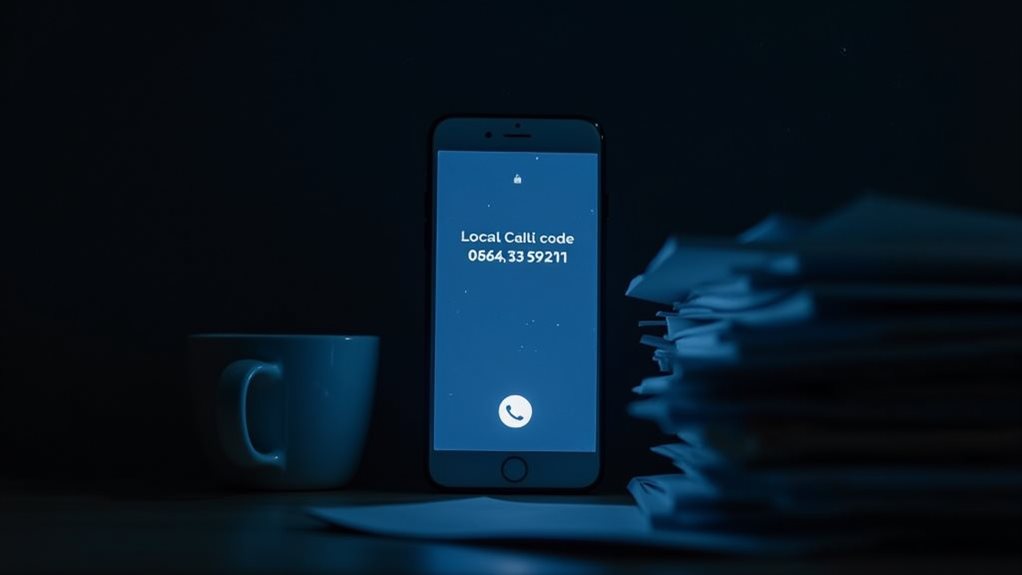Scammers primarily use Voice over Internet Protocol (VoIP) technology to manipulate caller ID displays, making their calls appear to come from legitimate sources or local numbers. They’ll often employ specialized software and prepaid PIN systems that require minimal technical knowledge to operate. Through neighbor spoofing, they’ll display local area codes to increase your likelihood of answering, while text message spoofing allows them to alter sender IDs for maximum deception. Understanding these techniques is your first step toward protecting yourself from their evolving tactics.
Understanding Phone Number Spoofing
While technology has made communication more convenient than ever, it’s also given scammers powerful tools to deceive unsuspecting individuals through phone number spoofing.
Using Voice over Internet Protocol (VoIP) services and web-based platforms, scammers can easily manipulate their caller ID to display any number they choose, making it nearly impossible to verify call authenticity.
You’ll find that these deceptive tactics often combine technical methods with social engineering techniques to appear legitimate. Scammers often employ caller ID spoofing to exploit trust and increase the likelihood of their calls being answered.
Through configurable software and digital alterations, scammers can make calls seem like they’re coming from trusted sources, such as your bank or a government agency.
They’re able to modify both the displayed phone number and caller ID name, creating a convincing facade that can trick even the most cautious individuals. Some scammers may even use background noise effects to enhance their deception.
Similar to prepaid calling cards, many spoofing services require users to dial a number, enter a PIN, and then input their desired fake caller ID number.
Common Service Providers and Their Methods
You’ll find that prepaid PIN call systems and web-based spoofing platforms represent two of the most accessible tools scammers use to manipulate caller ID information. These services often market themselves as legitimate business solutions, but they’re frequently exploited by fraudsters who purchase anonymous access to make untraceable calls. The primary goal of these scammers is to conduct identity deception attacks to gain unauthorized access to sensitive information. Modern scammers frequently rely on VoIP services to execute their spoofing schemes with ease, as VoIP fraud schemes take advantage of system vulnerabilities to facilitate scams. Web-based platforms, in particular, have made it easier than ever for scammers to operate, as they typically require minimal technical knowledge and can be accessed from anywhere with an internet connection.
Prepaid PIN Call Systems
Prepaid PIN call systems have become increasingly sophisticated tools in the hands of scammers who exploit various service providers’ features to mask their true identities.
You’ll find that these fraudsters often manipulate prepaid services through multiple channels, including phone cards, online platforms, and mobile services, all while bypassing traditional PIN security measures. As scams have evolved, many scammers have adopted spoofing techniques to increase the effectiveness of their fraudulent calls.
When you’re aware of how these systems work, you’ll notice that scammers typically access these services through toll-free numbers, then use stolen or fraudulent PINs to initiate calls that appear legitimate.
They’re particularly drawn to providers offering configurable caller ID features and PINless dialing options. Some criminals enhance their deception by adding background sound effects to make their calls seem more authentic.
What makes this method especially dangerous is how scammers can integrate multiple protocols and technologies, from SIP to GSM gateways, creating a complex web of deception that’s harder to trace. Scammers often target services that offer least cost routing to maximize their fraudulent activities while minimizing their expenses.
Web-Based Spoofing Platforms
As online communication technologies continue to evolve, web-based spoofing platforms have emerged as sophisticated tools that enable scammers to manipulate caller ID information with unprecedented ease.
These platforms offer user experiences designed to simplify the spoofing process, complete with deceptive user testimonials promoting their effectiveness. Many operate similar to prepaid calling cards, requiring users to enter PIN numbers and desired display numbers for outbound calls. Services like SpoofCard provide caller ID manipulation capabilities across multiple devices. You’ll find they operate through VoIP technology, allowing scammers to mask their true identity while making calls over the internet. Additionally, these platforms exploit anonymity tools to further obscure their real identity and location.
These services typically provide various payment plans and features, including voice changing capabilities and call recording options.
They’re particularly dangerous because they let scammers access multiple area codes and international numbers, making their deceptive calls appear legitimate.
When you’re receiving calls, it’s essential to remain vigilant, as these platforms make it increasingly difficult to distinguish genuine calls from fraudulent ones.
The Rise of Neighbour Spoofing Tactics

You’re likely to notice scammers using a particularly deceptive tactic called neighbor spoofing, where they’ll display phone numbers that match your local area code to gain your trust. These criminals understand that you’re more inclined to answer calls from numbers that look familiar, especially when they mirror the first few digits of your own phone number. In 2018, 70% of scam calls utilized local numbers to deceive potential victims. Modern scammers have enhanced their deception capabilities by using generative AI tools to create convincing voice clones. Using weak encryption methods can further facilitate eavesdropping risks during these calls, making it easier for scammers to exploit unsuspecting victims.
Local Area Code Tricks
The sophisticated tactic known as “neighbor spoofing” has become increasingly prevalent among phone scammers who’ve mastered the art of manipulating local area codes.
You’ll notice these deceptive calls often share your area code and first three digits, creating local number deception that’s designed to earn your trust.
When you’re facing caller identity confusion, it’s vital to understand that scammers use auto-dialing technology and VoIP services to make their calls appear legitimate. They often exploit VoIP technology to conceal their true identities and locations, making it challenging to trace them back.
They’re counting on your instinct to answer calls that seem familiar or local. Even if the number looks like it’s from your neighborhood or a nearby business, don’t let your guard down.
These spoofed numbers are carefully crafted to match your local calling patterns, making them particularly effective at deceiving unsuspecting recipients.
Psychological Trust Manipulation
With calculated precision, modern phone scammers exploit our natural tendency to trust familiar-looking numbers through sophisticated psychological manipulation tactics.
These trust exploitation techniques tap into your innate desire to connect with local businesses and neighbors, making you more likely to answer calls that appear familiar.
Here’s how scammers use psychological tactics to gain your trust:
- They manipulate caller IDs to display local area codes
- They mimic legitimate business numbers you might recognize
- They employ social engineering to build instant rapport
- They use persuasive conversation techniques to lower your defenses
When you answer these spoofed calls, you’re potentially adding yourself to a “sucker list,” leading to more scam attempts.
Understanding these manipulation strategies helps you protect yourself and your community from falling victim to these deceptive practices, as well as recognizing the risks associated with unreliable VoIP providers.
VoIP Technology in Number Manipulation
Modern Voice over Internet Protocol (VoIP) technology has revolutionized telecommunications while simultaneously creating dangerous opportunities for scammers to manipulate phone numbers.
You’ll find that VoIP vulnerabilities make it incredibly easy for fraudsters to alter their caller ID information, masking their true identity behind what appears to be legitimate phone numbers.
When you understand how Caller ID manipulation works through VoIP, you’ll see why it’s such a powerful tool for scammers.
They’re using specialized applications and hardware to send false information across voice networks, taking advantage of the system’s limited verification capabilities.
What’s particularly concerning is that there’s virtually no restriction on which numbers they can spoof, allowing them to impersonate trusted sources like your bank, government agencies, or local businesses. Additionally, these manipulations can lead to significant security risks for users, making it imperative to implement robust countermeasures.
Text Message Spoofing Techniques

Scammers have developed increasingly sophisticated techniques for spoofing text messages, making it harder than ever to distinguish legitimate communications from fraudulent ones.
Their deceptive messaging tactics include manipulating sender IDs and exploiting SMS protocols to make messages appear from trusted sources like your bank or delivery service.
You’ll want to watch out for these common SMS tactics:
- Altered sender IDs that mimic legitimate businesses
- Messages routed through compromised SMS centers
- SIM swapping to take over your phone number
- Phishing attempts disguised as security alerts
To protect yourself, always verify unexpected messages through official channels, and don’t click on suspicious links.
Tools Behind Caller ID Deception
Three main tools have emerged as favorites among fraudsters looking to deceive through caller ID manipulation: VoIP services, specialized spoofing apps, and GSM network exploits.
You’ll find services like SpoofTel and Bluff My Call offering features that enable caller identity theft through simple interfaces, making it disturbingly easy for scammers to mask their true numbers.
While these tools may have legitimate uses in certain business contexts, their widespread availability raises serious spoofing ethics concerns.
Popular applications like Dingtone allow users to obtain real phone numbers without SIM cards, while more technical approaches involve Linux-based systems using Asterisk software.
If you’re receiving suspicious calls, consider using reverse lookup services or real-time identification tools to protect yourself from these deceptive practices. Implementing call-blocking features can also help mitigate the risks associated with these fraudulent activities.
Real-World Examples of Spoofing Attacks

As phone spoofing technology has evolved, criminals have developed increasingly sophisticated attack strategies that target vulnerable individuals and organizations.
These real life scenarios reveal common scammer tactics you’ll want to watch out for to protect yourself and your loved ones.
Common spoofing attacks you might encounter include:
- Utility scammers threatening to cut off your services unless you make immediate payment
- Police impersonators demanding payment for supposed fines or warrants
- Tax scammers claiming you owe money to the government
- Local number spoofing that makes calls appear to come from your area
You’ll often notice these scammers create artificial urgency to pressure you into acting quickly.
They’re counting on fear and confusion to override your better judgment, which is why it’s essential to stay informed about their methods.
Financial Impact on Victims
Phone spoofing scams have inflicted devastating financial losses on individuals and businesses alike, with the average victim now losing over $560 per incident.
You’ll find that victim experiences often include unauthorized purchases, stolen identities, and compromised bank accounts, which can take months or even years to recover from.
If you’re running a business, the impact can be particularly severe.
You’re not just facing immediate financial losses; you’re also dealing with potential fines, customer refunds, and long-term reputation damage that can affect your bottom line.
Senior citizens in your community are especially vulnerable, experiencing higher losses than any other age group.
The path to financial recovery isn’t easy, but understanding these risks is your first step toward protecting yourself and your assets. Additionally, many small businesses are turning to cost-effective VoIP solutions to enhance their communication systems and improve security against such scams.
Legal Framework and Regulations

A complex web of laws and regulations governs the fight against phone number spoofing across different countries.
While you’ll find different legal implications in each jurisdiction, there’s a growing global effort to combat this deceptive practice.
Here’s what you need to know about the regulatory challenges in major regions:
- The US enforces the Truth in Caller ID Act, imposing fines up to $10,000 per violation.
- The UK allows telecom regulators to fine direct marketing companies up to £2 million.
- India treats spoofing as a criminal offense with potential jail time.
- International cooperation is increasing through frameworks like STIR/SHAKEN.
You’re protected by these regulations, but it’s crucial to stay informed about your rights and reporting options in your region.
If you suspect spoofing, don’t hesitate to report it to your local authorities.
Prevention Strategies and Best Practices
While scammers constantly develop new ways to spoof phone numbers, you’ll find several proven strategies to protect yourself from becoming their next target.
Start by enhancing your phone security through spam blockers and anti-spoofing apps, which can effectively filter out suspicious calls. You’ll also want to take into account using data removal services to minimize your digital footprint and reduce the risk of your number being compromised.
Don’t forget to register on the Do Not Call Registry and monitor your call history regularly for any unusual activity. If you suspect your number’s been spoofed, notify your carrier immediately.
Frequently Asked Questions
Can Spoofed Phone Numbers Be Traced Back to Their Original Source?
You’ll find it’s extremely difficult to trace spoofed numbers due to traceability challenges and caller ID manipulation. Most scammers use international services and VoIP technology that make tracking nearly impossible.
How Long Do Scammers Typically Keep Using the Same Spoofed Number?
You’ll find scammers rarely stick with one number for long. They’re constantly using temporary numbers and rotating through different ones, often changing them daily or weekly to avoid detection and maintain effectiveness.
Do Phone Carriers Actively Monitor and Block Suspected Spoofed Numbers?
Yes, your phone carrier actively works to protect you. They’ve implemented sophisticated spoofing detection systems and robust blocking policies. You’ll often see suspicious calls labeled or blocked before they reach you.
What Happens to Scammers Who Get Caught Spoofing Phone Numbers?
You’ll find that caught scammers face serious legal consequences, including hefty fines and potential jail time. If you’re wondering about criminal penalties, they can serve up to 13 years behind bars in severe cases.
Can Anti-Spoofing Technology Completely Eliminate Phone Number Spoofing Attacks?
No, you can’t rely on anti-spoofing solutions to completely stop these attacks. Due to technology limitations and the nature of VoIP services, scammers can still find ways to bypass protective measures we’ve developed.
Final Thoughts
You’ve learned how scammers exploit phone spoofing technology through various methods, from VoIP manipulation to neighbor spoofing tactics. While these techniques become increasingly sophisticated, you’re now equipped to recognize and protect yourself against such deceptive practices. By staying informed about current spoofing methods, implementing recommended security measures, and following best practices, you’ll greatly reduce your risk of falling victim to phone-based fraud.

